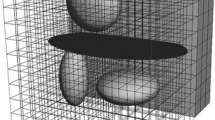Abstract
This paper presents a fast and accurate solution for crack interaction problems in infinite- and half- plane solids. The new solution is based on the method of complex potentials developed by Muskhelishvili for the analysis of plane linear elasticity, and it is formulated through three steps. First, the problem is decomposed into a set of basic problems, and for each sub-problem, there is only one crack in the solid. Next, after a crack-dependent conformal mapping, the modified complex potentials associated with the sub-problems are expanded into Laurent’s series with unknown coefficients, which in turn provides a mechanism to exactly implement in the form of Fourier series the boundary condition in each sub-problem. Finally, taking into account the crack interaction via a perturbation approach, an iterative algorithm based on fast Fourier transforms (FFT) is developed to solve the unknown Fourier coefficients, and the solution of the whole problem is readily obtained with the superposition of the complex potentials in each sub-problem. The performance of the proposed method is fully investigated by comparing with benchmark results in the literatures, and superb accuracy and efficiency is observed in all situations including patterns where cracks are closely spaced. Also, the new method is able to cope with interactions among a large number of cracks, and this capability is demonstrated by a calculation of effective moduli of an elastic solid with thousands of randomly-spaced cracks.
Similar content being viewed by others
References
Andersson H (1969) Stress intensity factors at the tips of a star-shaped contour in an infinite tensile sheet. J Mech Phys Solids 17: 405–414
Benveniste V, Dvorak GJ, Zarzour J et al (1989) On interacting cracks and complex crack configurations in linear elastic media. Int J Solids Struct 25: 1279–1293
Bristow JR (1960) Microcracks and the static and dynamic elastic constants of annealed and heavily cold-worked metals. British J Appl Phys 11: 81–85
Budiansky B, O’Connell RJ (1976) Elastic moduli of a cracked solid. Int J Solids Struct 12: 81–97
Carvalho FCS, Labuz JF (1996) Experiments on effective elastic modulus of two-dimensional solids with cracks and holes. Int J Solids Struct 33(28): 4119–4130
Chen WH, Chen TC (1995) An efficient dual boundary-element technique for a 2-dimensional fracture problem with multiple cracks. Int J Numer Methods Eng 38(10): 1739–1756
Cooley JW, Tukey JW (1965) An algorithm for the machine calculation of complex Fourier series. Math Comput 19: 297–301
Denda M, Dong YF (1997) Complex variable approach to the BEM for multiple crack problems. Comput Meth Appl Mech Eng 141: 247–264
Erdogan F (1962) On the stress distribution in plates with collinear cuts under arbitrary loads. In: proceedings of 4th U.S. national congress of applied mechanics, vol 1, ASME, pp 547–553
Erdogan F (1969) Approximate solutions of systems of singular integral equations. SIAM J Appl Math 17(6): 1041–1059
Erdogan F, Gupta GD (1972) On the numerical solution of singular integral equations. Q Appl Math 29: 525–534
Feng XQ, Li JY, Yu SW (2003) A simple method for calculating interaction of numerous microcracks and applications. Int J Solids Struct 40: 447–464
Gupta GD, Erdogan F (1974) The problem of edge cracks in an infinite strip. J Appl Mech Trans ASME 41(4): 1001–1006
Hashin Z (1988) The differential scheme and its application to cracked materials. J Mech Phys Solids 36: 719–734
Isida M (1972) Method of Laurent expansion for internal crack problems. In: Sih GC (eds) Methods of analysis and solutions of crack problems. Martinus-Nijhoff, The Hague
Kachanov M (1987) Elastic solids with many cracks: a simple method of analysis. Int J Solids Struct 23: 23–45
Kachanov M (1993) Elastic solids with many cracks and related problems. Adv Appl Mech 30: 259–445
Kachanov M (2003) On the problems of crack interactions and crack coalescence. Int J Fract 120: 537–543
Koiter WT (1959) An infinite row of collinear cracks in an infinite elastic sheet. Ingenieur Archiv 28: 168–173
Kushch VI, Shmegera SV, Buryachenko VA (2005) Interacting elliptic inclusions by the method of complex potentials. Int J Solids Struct 42(20): 5491–5512
Li YP, Tham LG, Wang YH et al (2003) A modified Kachanov method for analysis of solids with multiple cracks. Eng Fract Mech 70: 1115–1129
Ma L, Wang XY, Feng XQ, Yu SW (2004) Numerical analysis of interaction and coalescence of numerous microcracks. Eng Fract Mech 72: 1841–1865
Muskhelishvili NI (1953a) Some basic problems of the mathematical theory of elasticity. P. Noordhof, Groningen
Muskhelishvili NI (1953b) Singular integral equations. Noordhof, Groningen, The Netherlands
Pan E (1997) A general boundary element analysis of 2-D linear elastic fracture mechanics. Int J Fract 88: 41–59
Sih GC (1964) Boundary problems for longitudinal shear cracks. In: proceedings of 2nd conference on theoretical and applied mechanics. Pergamon, New York
Sneddon IN, Lowengrub M (1969) Crack problems in the classical theory of elasticity. Wiley, New York
Tada H, Paris PC, Irwin GR (1985) The stress analysis of cracks handbook. Paris Production and Del Reasearch Corporation, St. Louis
Westergaard HM (1939) Bearing pressures and cracks. J Appl Mech 6: A49–A53
Willmore TJ (1949) The distribution of stress in the neighborhood of a crack. Q J Mech Appl Math 2(1): 53–64
Xue MD, Li DF, Hwang KC (2004) Analytical solution of two intersecting cylindrical shells subjected to transverse moment on nozzle. Int J Solids Struct 41(24–25): 6949–6962
Xue MD, Li DF, Hwang KC (2005) Theoretical stress analysis of intersecting cylindrical shells subjected to external loads transmitted through branch pipes. Int J Solids Struct 42(11–12): 3299–3319
Author information
Authors and Affiliations
Corresponding author
Rights and permissions
About this article
Cite this article
Li, DF., Li, CF., Shu, SQ. et al. A fast and accurate analysis of the interacting cracks in linear elastic solids. Int J Fract 151, 169–185 (2008). https://doi.org/10.1007/s10704-008-9249-8
Received:
Accepted:
Published:
Issue Date:
DOI: https://doi.org/10.1007/s10704-008-9249-8




